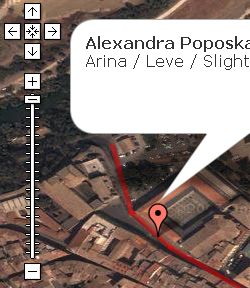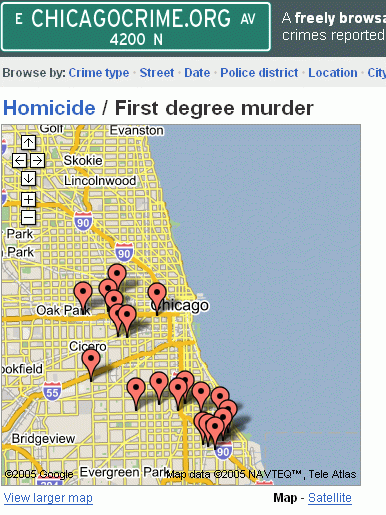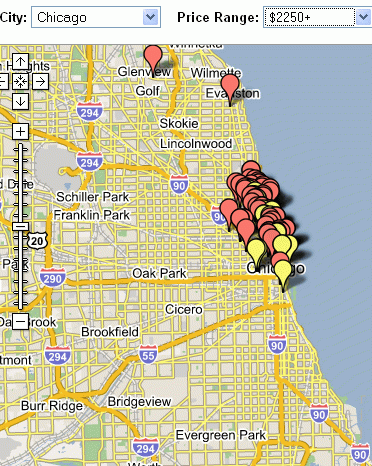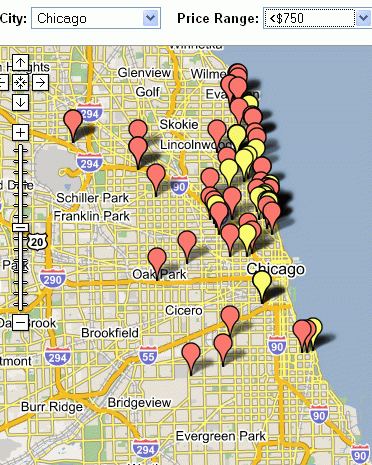English-language version of Luistxo Fernandez's blog
Tagzania, folksonomy meets Google Maps
After playing with Google Maps for the San Fermin running of the Bulls trick (it even got a mention at Der Spiegel in Germany!), now a more serious application:
We call it Tagzania.
Folksonomy like at del.icio.us of Flickr, but applied to maps. Tagzania follows the del.icio.us model but instead of URL locations, you save geographic locations and then see them plotted in maps: your own maps, or shared ones (by tags).
Social software meets Google Maps. That's the intention. We'll see if the idea catches.
Tagzania has also its blog. It will be probably me, Luistxo, who will write there most of time, with this broken english of mine. Probably the English side of the Cemetery will be more silent from now on.
The first blog out there to spot Tagzania has been Jay Knight's. His praise litfs my spirit today. Word of mouth is the chance to get users and see the application flourish.
Running of the Bulls in Pamplona Googlemapped
Following the sad news from London, today's not the best day to show a map with injured people plotted in it. But well, this is what we made this morning before we got the news: the San Fermin map, as today is the San Fermin day, 7th of July.

It's a multitude event in Spain, the running of the Bulls at San Fermin Festival in Pamplona. Today it was the first running, the first encierro. We will add everyday's chronicle for a week. Check http://www.codesyntax.com/proiektuak/sanfermin.html
We're working in more dynamic and interesting developments and hope to share those with you in the near future. The San Fermin gmap is just a showcase.
We believe that usage of GoogleMaps to ilustrate news will be ground for intense development and fruitful ideas. Sometimes it will be sad news that will be plotted into the maps. Hopefully, there will be occasions to use the maps for more joyful reasons.
Political case study for Localizer/Zope in Europython
Next wednesday, on June 27, my coleagues from CodeSyntax Josu Azpillaga and Mikel Larreategi will give a presentation at then Europython 2005, meeting in Goteborg (Sweden), about success case studies involving Localizer. They are going to talk about the the last election process in the Basque Country (held in april 2005). These were the first elections in Spain in which blogs, W3c-validated sites and truly dynamic websites were used by campaigners in the Internet.
Acustomer of us won, Ibarretxe.com , fully Zope, fully bilingual thanks to Localizer. The task that we had as Internet web providers for this client was:
- The message of the political campaign, which would be distributed by mainstream media channels or usual electoral activities, had to be present in the Internet as well.
- The candidate had to be the smartest and most modern. As far as Internet and tech usage was involved, we wanted the website to excel above the rest.
As webmakers, we were fairly satisfied with the results in both fronts, and we believe that the client (a coalition of parties, not a personal campaigner, although the campaign was very much personalized in his person, in Juan Jose Ibarretxe) was happy as well. Feedback and references received in Internet (particularly blogs and else that we tracked through Technorati and Bloglines) and some comparatives, showed good results.
The main point for success were:
- Good design, usable and fast. Campaign image (created by external advertising agencies) was smoothly integrated. No friction between advertisers, the client and the webmakers.
- RSS, standarsds, validating HTML... No other candidates offered anything like that.
- Content, always renewed, well structured, multimedia files as well.
- Blogs, a novelty in political communication in Spain, and other spicy sections, like a del.icio.us and RSS based linkroll with commented links (mostly ironic comments about anti-Ibarretxe articles).
- Perfect bilingualism in Basque and Spanish, sustained by good i18n and l10n.
That will the point at Gotebor, how we managed languages in this complex website, with Zope and Localizer.
We were very pleased with the result achieved.
Interfaces were well localised, and coordinated with other services (email notifications or the software for the newsletters, Mailman, was localised as well in Spanish and Basque, and tuned with the language choice originated in the website).
Content was parallel in many parts of the website, but other parts were asymmetric. In symmetric parts, language change worked in every page, even in videos concerning a particular issue.
But for asymmetric content, we had thought about that as well. The blog, for instance. There's no thing like a bilingual thread... There has to be a blog in one language, and another one, with different posts and comments in other language. The del.icio.us based linkroll was also asymmetric.
Language-policy was also tuned accordingly to the client's preference. In this case, no entry page to choose language. The front page appeared in one or other language depending on browser language preference. We discussed positive discrimination about Basque, but the client decided the other option. Not a bad choice, in our opinion. In the credits section we put it clear, how users could tune their browser if they wanted to see the frontpage in Basque. However, that was for the first visit, in following visits, a cookie remembered each users' last language of interaction in the website.
Using Localizer
These points described above could be achieved with Localizer. Many features of the product were used. Perhaps all features? Maybe...
- Language policy, of course, like the one that we describe, or many other configurations, can be set up with Localizer.-
- Interface messages using a messahe catalog. Of course, variables are needed, not dumb dictionaries, and Localizer provided it. It must be noted that Spanish and Basque are unrelated languages and have very distinct syntaxes. Word order is very odd in Spanish or most European languages, seen from the Basque point of view.
- Logic in the programming level. Different ways to treat date formats, for instance, or the internal search engine, that searched in two distinct catalogs, one per language.
- For parallel content, a variable of the LocalContent module created by CodeSyntax was used.
- For asymmetric content, different localised methods were used, and, for news and the blog, a modified version of Squishdot totally i18n-ed for Localizer.
- Language change: in parallel content, the changeLanguage method of Localizer works smoothly. But in asymmetric content, we tuned it a little bit with the
gotovariable... You are reading comments in a blog article and you cannot change the language to see those comments in the other language: it is asymmetric content, no automatic translation exists there... so, the interface language must be changed, but the user also needs to be redirected: in that case, to the blog frontpage in the other language.
Not only technique
Of course, it was not just i18n expertise. The client was commited, and its structures were ready to provide content in both languages as well as to attend feedback of users in Basque and Spanish. Several candidates chatted through the web in realtime, and all of them first interacted in Basque, and then in Spanish, with written questions that came from the web. An ad campaign in Google also targeted Basque and Spanish terms, with adwords written in both languages, and offered clicks to Basque or Spanish pages, accordingly, of course.
So, the candidate finnally won. But his majority was scarce, it must be said, the formation of the regional government has been delayed in the regional parliament for two months, and it was not until this past weekend that Ibarretxe has been appointed lehendakari, that is, president of the Basque autonomous region.
During these two months, the website has worked in a strange mood... like waiting for the future. But, now it will be time to redesign the website for a 4-year term, in which, we hope, the client will manage by themselves this website.
References
We collected some references comparing the election site of Ibarretxe with others. They are in Spanish, so check the links at the end of this post in Spanish.
Transaction and information in e-gov, in Bremen, and in Gipuzkoa
Martin Hagen of Bremen gave us a good presentation about his work as a e-government official at his city-state in Germany. This was the most interesting thing we heard at the 2nd and final day of the e-government meeting at San Sebastian.
Hagen explained us that there are three layers for the presence of govt. in the internet:
- Information
- Communication
- Transaction
Although his work and, therefore, the focus of his presentation was on the 3rd layer, he stressed that the biggest use of Internet by citizens is in the 1st level. His own data and conclusions about the transactions that really take place in Bremen, which has a complete catalogue of e-services, also leads to that conclusion:
- Intermediaries account for the most part of usage of e-services / transactions.
It's logic. We don't want to pay fines by Internet. We don't want to pay them at all. It is lawyers, tax agents and businesses that want to do that, because it´s part of their function. And, yes, we at the end, citizens, pay our taxes, but mostly through intermediaries. So, as Martin explained, e-services have to be marketed towards businesses and intermediaries. Good point. I completely agree.
The situation in Gipuzkoa (or the Basque Country at large)
Would the organizers, the local authorities of Gipuzkoa in the Basque Country, draw the same conclusion? I doubt it. They presented us with a complete citizen service in which, if we get a certification card, we may access the car fines we haven't paid since the 80s... Ummmm, is that really what we citizens want?
Moreover, not only that, but they think that this kind of service may be delivered by digital TV, in some Gipuzkoa.tv channel with administrative information... Will that bring down the TV share of CSI or sports? Broadcasters must be terrified, I guess.
Yet, most of the Internet efforts of Gipuzkoa fail at point 1, of the list that Martin presented: Information. It's diffficult to reach, chaotic, incomplete, and RSS or concepts like web services have been, so far, completely alien to them.
But well, they are focused on layer 3, and want to do that also by TV and m-governmnet, and who knows. That TV scheme seems expensive, on a scale of 1-10000 at least, compared to what may cost a complete RSS-fication of public information in Gipuzkoa. What does this mean? That there will be more marketeers from bigger companies pushing for the big TV project, taking their handful of euros, and that the other possible RSS project may well be regarded as unimportant.
Good practices in Gipuzkoa? Yes, they are, ignored by authorities
And it´s not that difficult to do work on layer 1: information. That´s what citizens want, not fines. No very much examples of Basque administrations giving information properly were provided... Of course, organizers were blind to people that work in Gipuzkoa... They forgot who are the real bloggers here (Eibar.org and Goiena.net, both with technology provided by our company CodeSyntax), instead gave free propaganda to the Diario Vasco media powerhouse; and they also forgot the work done by CodeSyntax and Goiena as software and content-management providers of some of the town councils with the finest websites in Gipuzkoa. Take Eskoriatza two languages, easy interface, just information, not much more than that, but easy to use, and managed by a contract that the town council has with Goiena a local media cooperative company. RSS, email bulletins and easy to use HTML that provide continous information in two languages...
And, then, in parallel, Goiena serves the community with a portal for news, discussion and participation, with bloggers from the town, fora and else. A place for true citizne participation, don't know if it may be labelled e-democracy...
There they had a nice model: and there's a department in Gipuzkoa's main authority called Innovation and Society of Information that doesn't even know that these things exist.
Thumbs up and thumbs down for Martin Hagen
Two notes more about Martin's presentation:
- They asked Martin to provide other good European examples, and he mentioned Austria's e.gov portal. Well, that is Zope, again.
- It's sad that many features of Bremen Online don't seem to work with Firefox...
E-democracy and citizen participation in public discussions with Zope
Half-interesting meeting in town. The interesting half was that of Steven Clift, whom I didn't know, but who gave us interestig notes and examples of what e-democracy is currently in the Internet.
The boring part was of the propaganda that the main Spanish paper here, Diario Vasco, got freely from the sponsors of the event: a sermon about them being the voice of the people and the true bloggers of this country... The program even has printed lies that this paper, part of the Spanish right-wing group Vocento, hosted the first blog community of Gipuzkoa. False, Basque-language blog communities like this one in Eibar.org were first, and among media organizations, Goiena.net was also earlier, not those liars. It's a shame that public authorities of Gipuzkoa only regard the media power of Spanish right-wingers and not even notice the existence of Internet communities that interact in Basque, the local language.
But returning to the interesting part, Mr. Clift He has great expertise in the field, first developed in Minnesota, and is consulting and informing about e-gov and e-democracy since long ago. There's a community of people following him and discussing issues with him at Dowire.org. I think I'll subscribe and join the pack. Never late to learn.
Clift has praised several govts. that provide multiple e-mail choices to susbcribe to public information and news. He has talked less about RSS, but mainly because he considers it, as for now, only suited for the top-elite of Internet users, which is probably true. However, the option to integrate gov information into other media or citizen sites through RSS syndication is a point that he has stressed and he has provided the example of Northfield.org were feeds from administrator's blogs are included in the sidebox (look at the Civic Blogosphere section). Other example that he showed us, the full list of RSS provided by Alberta province,. Good example. Many should learn.
As of citizens participating in public debates... He has mentioned some example that look promising, like the one fostered in Queensland, Australia. But there's the issue of moderation, openness, critic mass of users... Not very convinced about e-democracy forums in official sites. I think there's more true e-democracy at Northfield, for instance. Or at Clift's latest project, Issues Forum UK, not directly a government project.
However, they were all nice examples of usage of technologies.
I was interested in talking to him after his presentation, and it was while chatting that I got the big surprise: I mentioned him Aurki.com, an aggregator for Basque blogs and RSS sources, and he asked me about technology; what did we use? Well, Universal Feed Parser, a Python product. And Steven replies: Well, Issues Forum and the Groupserver software that runs it is based in Zope and Python. Ummm... That's our software here at Eibar.org , what we use at our company !
That's a guy with a project, and both deserve to be followed.
The English Cemetery mentioned in The Financial Times
The English Cemetery gets a mention at The Financial Times! Well, not this blog, but the real cemetery...
Kieran Cooke wrote one of those lifestyle chronicles that appear at dailies for the weekend, on Friday, May 13th... Titled On the trail of Basque delights this Kieran has some romantic viewpoints about the Basques. Like everybody, he falls in love with Donostia the city (San Sebastian) and, this is stranger, he mentions the Cemetery:
There is a British cemetery: Colonel Tupper ended his days in the mid 19th century fighting in Basque country. Not a bad place to finish up: it was in those times that San Sebastian became fashionable among Europe's aristocracy.
I'm not sure about the timing. That fashionable era came later than the wars that buried englishmen at the Cemetery. However, thanks Kieran for spotting this little corner of the world.
Got this news from Txikilike-Blex, a Basque-american blogger. The FT article requires registration but Txikilike pasted the whole text here.
On a related note, The English Cemetery (the blog, in this case), got also a mention at the New York weekly The Jewish Week. It was because of my post about the Basque lullaby copied in Israel.
Semantic maps
Chicagocrime.org a web site with all reported crimes in Chicago, browsable by time, type of crime, type of location, and lets that be viewed through Google Maps.
Now you combine that with HousingMaps (a clear inspiration for Chicagocrime, I guess), search for housing at Chicago, and what do you get? The semantic web, a map plotting housing availabiliy and price in relation to crime rates in a given city.
In this case, the area with more terrible crimes has almost no Craigslist listings shown at HousingMaps...
Compare images for Homicides and the cheapest as well as the most expensives offerings:



Limit size to embedded images in Coreblog
Regarding the feature to embed pictures into Coreblog posts, which he have included in CodeSyntax's modified Coreblog version, an additional recipe that comes handy to limit size of pictures added by people.
As it is noted by the Blogplot crew at this message, , users may get used to upload images of any size. As they are automatically resized, people with no clues about storage at blogs may upload too much Mb's.
So the Blogplot people devised a system to put maximum image size at 100 Kb. I asked Brady of Blogplot for the recipe, and got it. I just posted it to Coreblog-en mailing list: there it is
Credit goes to Brady Davis and Jeff Hicks. Thank you.
Hear the Basque original lullaby for Naomi Shemer's Jerusalem of Gold
It's frontpage news in Israel, apparently. The song Jerusalem of Gold (Yerushalyim shel Zahav) was not an original creation of its composer, Naomi Shemer, but a copy of a Basque lullaby...
Haaretz has the story "quite right,": mentioning the Basque singer who was heard by Shemer (or by Shemer's friends): Paco Ibañez. But Haaretz fails translating the lullaby's title: it's not Joseph's Hair! The lullaby is Pello Joxepe, a male name, translatable like Peter Joseph. Perhaps someone took Basque Pello, and transformed it into Spanish Pelo (hair)?
You may hear Ibañez singing that at this record Real Audio will let you hear some seconds there...
Pello Joxepe is a well known song among Basques, but rather than in that soft melody used by Ibañez and copied by Shemer, in a rather different more joyful melody. The copied melody, in turn, seems to be a popular melody adapted to many songs... Other Basque artists have recorded it as Mikel Laboa singing "Ihes ederra" (Laboa used the traditional melody to put music to a writer's poem) or the group Hiru Truku singing "Bart hamarretan" (a traditional song).
As for reactions to the copying act... Nobody's outraged here at the Basque Country. We are such a little nation... we feel proud anytime someone notices us for something good (a nice tune, for instance).
Modified Coreblog released by CodeSyntax
Here it is: a new Coreblog development. See the demo and download the modified product, instructions and else from CodeSyntax
This modified Coreblog is in usage in a Basque blog community at Goiena with examples like Zinema , Faroa or Superbai
In those blogs, users (individual bloggers, as opposed to the website managers of Goiena.net) need no Zope knowledge.
- Editing and managing interfaces taken out of ZMI, and they have been localised
You cannot access the editing interfaces in the examples or in the demo, but I posted an image at this blog entry, so you can have an idea.
Other features:
- Date is editable. You can change date & time of posting, whenever you want.
- Comment and trackback control interfaces integrated into the general entry management view
- A micro-CMS so the user can manage fixed content, upload files and images.
- Template changes only through the CSS, but the CSS can be directly accessed and edited by the user. Design follows a Movable-Type 3 layout, so you can adapt any CSS layout of that kind and apply it.
A good place to get CSS's is MovableStyle.com . Check the MT3 category: the styles fit nicely. Those with images in the background require more homework, but the pure CSS's are just copy, paste, save and see.
- All that is localised, with versions ready for English, Spanish and Basque, and the possibility to easily deploy other languages.
- Image addition and management: pictures get embedded into posts. Just mentioned on the "previous post."http://www.eibar.org/blogak/luistxo/en/353
